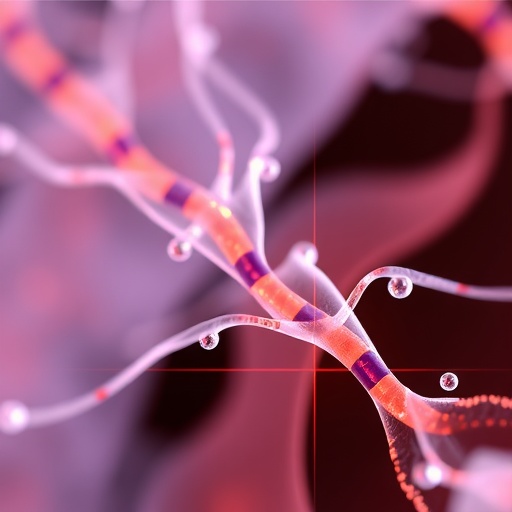In a groundbreaking leap toward the future of implantable bioelectronics, researchers have unveiled a novel class of soft, multifunctional fibers capable of integrating a high density of sensing and stimulation components within a remarkably small and flexible architecture. This innovation addresses long-standing challenges that have hindered the development and implementation of bioelectronic fibers, particularly the difficulties in embedding numerous active elements into one-dimensional devices without compromising flexibility or biocompatibility.
The advancement centers on a transformative fabrication process known as “spiral transformation,” where two-dimensional thin films harboring microfabricated devices are geometrically reconfigured into one-dimensional, cylindrical fibers. This inventive method not only allows for precise spatial control over the longitudinal, angular, and radial distribution of active components but also enables the creation of highly compact, soft fibers dense with multimodal bioelectronic functionality. Such a capability circumvents the limitations imposed by traditional microfabrication methods like photolithography, which struggle to conform devices onto thin, curved, and elongated fiber substrates.
Existing bioelectronic fibers have historically been plagued by rigidity, low density of active components, and constraints on layout precision. These factors have restricted their usability in dynamic biological environments, particularly where soft tissue interfaces demand highly flexible and biocompatible devices. The newly developed Spiral-NeuroString (S-NeuroString) fibers directly confront these challenges, offering a pliant, minimally invasive platform that supports a diverse array of sensing and stimulation capabilities within a single fiber structure.
One of the most compelling demonstrations of the S-NeuroString’s potential lies in its application to the gastrointestinal system of awake, behaving pigs. The soft fibers exhibit excellent biocompatibility and mechanical compliance with the complex and constantly moving environment of the gut. This compatibility facilitates continuous multimodal monitoring of gut motility, a critical physiological parameter, alongside the capability for targeted electrical stimulation. Such functionality signals a significant step forward for post-operative monitoring and real-time therapeutic interventions in clinical settings.
Beyond gastrointestinal applications, the researchers have showcased the power of their fibers for neuroscience research. In vivo experiments involved chronic implantation of multi-channel arrays for electrical recording within mouse brains. Remarkably, these fibers maintained stable single-unit activity recordings for up to four months, pointing to their durability and minimal tissue response over extended periods. This achievement addresses a longstanding need for long-term neural interface devices that maintain signal fidelity without causing chronic tissue damage.
The extraordinarily high channel count achievable within these fibers is another distinguishing feature. The research team fabricated an S-NeuroString fiber featuring an unprecedented 1,280 independent channels embedded within a soft fiber only 230 micrometers in diameter. This level of integration opens exciting avenues for capturing spatially rich neural and physiological data, which could revolutionize brain-machine interfaces, prosthetics, and biofeedback-controlled therapeutic devices.
Technically, the spiral transformation fabrication approach allows for unique arrangements of functional components within the fiber cross-section, including electrodes, sensors, and microstimulators. By carefully designing the initial planar devices and transforming them into spiraled fibers, the devices achieve an optimized spatial organization that enhances sensing resolution and functional multiplexing without compromising flexibility or mechanical robustness.
The use of soft materials further enhances the fibers’ suitability for chronic implantation. The fibers’ elastic properties closely match those of surrounding biological tissues, dramatically reducing mechanical mismatch, which is a primary driver of inflammation and scarring in implantable devices. This compliance, paired with precise control over device architecture, represents a new paradigm in designing bioelectronic interfaces that harmonize with the body’s natural movements.
Moreover, the multimodal sensing capabilities embedded within these fibers encompass a wide range of physiological signals, from electrophysiological recordings to chemical sensing modalities. This rich data spectrum facilitates a more comprehensive understanding of complex biological systems, enabling researchers and clinicians to develop nuanced treatment strategies tailored to individual physiological states.
From a clinical perspective, the S-NeuroString fibers hold particular promise for minimally invasive implantation procedures. Their slender profile and mechanical softness allow navigation through constrained biological pathways with minimal tissue disruption. This advantage is critical for translating advanced bioelectronic devices into practical medical tools for diagnostics, therapeutics, and long-term health monitoring.
In sum, the introduction of the Spiral-NeuroString technology marks a pivotal advancement in bioelectronic device engineering. It marries state-of-the-art microfabrication techniques with revolutionary geometric design principles to realize ultra-dense, soft, and biocompatible fibers capable of complex multimodal functionality. This breakthrough opens new frontiers for implantable electronics, offering transformative potential for neuroscience, gastroenterology, and beyond.
The multidisciplinary nature of this work, intersecting materials science, microengineering, biology, and medicine, underscores the growing importance of integrated approaches to tackling challenges in bioelectronics. As these advanced fibers progress toward clinical adoption, they are poised to enable a new generation of diagnostics and therapies that seamlessly interface with the human body in both health and disease.
Ultimately, the high-density soft bioelectronic fibers developed through spiral transformation set a compelling benchmark for future research and innovation. By overcoming key obstacles related to component density, flexibility, and spatial control, they illuminate a path toward next-generation bioelectronic systems that are minimally invasive, highly functional, and long-lasting.
Subject of Research: High-density soft bioelectronic fibers for multimodal sensing and stimulation.
Article Title: High-density soft bioelectronic fibres for multimodal sensing and stimulation.
Article References:
Khatib, M., Zhao, E.T., Wei, S. et al. High-density soft bioelectronic fibres for multimodal sensing and stimulation. Nature 645, 656–664 (2025). https://doi.org/10.1038/s41586-025-09481-2
Image Credits: AI Generated
DOI: https://doi.org/10.1038/s41586-025-09481-2
Tags: advanced sensing technologiesbiocompatible sensing componentsflexible bioelectronic deviceshigh-density biofibersimplantable bioelectronicsinnovative fiber architecturemicrofabrication challengesmultifunctional soft fibersmultimodal bioelectronicsnovel biofibers for sensingsoft tissue interfacesspiral transformation fabrication





